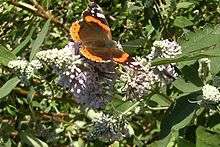Buddleja officinalis
| Buddleja officinalis | |
|---|---|
 | |
| B. officinalis with Red Admiral in January, UK. | |
| Scientific classification | |
| Kingdom: | Plantae |
| (unranked): | Angiosperms |
| (unranked): | Eudicots |
| (unranked): | Asterids |
| Order: | Lamiales |
| Family: | Buddlejaceae |
| Genus: | Buddleja |
| Species: | B. officinalis |
| Binomial name | |
| Buddleja officinalis Maxim. | |
| Synonyms | |
| |
Buddleja officinalis is a deciduous early-spring flowering shrub native to west Hubei, Sichuan, and Yunnan provinces in China.[1] Discovered in 1875 by Pavel Piasetski,[2] a surgeon in the Russian army, B. officinalis was named and described by Maximowicz in 1880. Introduced to western cultivation in 1908, B. officinalis was accorded the Royal Horticultural Society's Award of Merit three years later,[3] and the Award of Garden Merit (record 689) in 2002.
Description
B. officinalis largely resembles the commoner B. davidii in shape and size, growing to < 2.5 m in height. The inflorescences are honey-scented mauve panicles, shorter (< 8 cm) than those of davidii, and more conical. The leaves are lanceolate, < 15 cm long, softly pubescent, the upper surface rich green in colour, the underside grey.[1] 2n = 38.[4]
Cultivation
B. officinalis is not fully frost hardy, unable to survive temperatures lower than – 10° C., and is best grown against a south-facing wall.[1] The shrub should be cut back hard each year immediately after flowering in spring. Propagation by softwood cuttings is easily accomplished, using vermiculite as a rooting medium.
In the UK the shrub is often grown as a nectar source for vanessid butterflies such as the Peacock on emergence from hibernation.[5] Hardiness: RHS H2, USDA zones 8 – 9.
References
- 1 2 3 Phillips, R. & Rix, M. (1989). Shrubs. Pan Books, London. ISBN 0-330-30258-2
- ↑ Bryce, W. J. (2007). Pavel Yakovlevich Pyatsetski (1843 – 1919): his botanical collections in China (1875) and paintings of Chinese gardens. Archives of Natural History. Vol. 39, pp 171 – 174. ISSN 0260-9541, E-ISSN 1755-6260. Edinburgh University Press.
- ↑ Hillier & Sons. (1977). Hilliers' Manual of Trees and Shrubs, 4th Edition. David & Charles, Newton Abbot, England. ISBN 0-7153-7460-5
- ↑ Chen, G, Sun, W-B, & Sun, H. (2007). Ploidy variation in Buddleja L. (Buddlejaceae) in the Sino - Himalayan region and its biogeographical implications. Botanical Journal of the Linnean Society. 2007, 154, 305 – 312. The Linnean Society of London.
- ↑ Brookes, A. H. (2007). Winter flowering buddlejas. Plant Heritage: Hampshire and Isle of Wight Group, Spring 2007.. Plant Heritage, UK.
- Leeuwenberg, A. J. M. (1979) The Loganiaceae of Africa XVIII Buddleja L. II, Revision of the African & Asiatic species. H. Veenman & Zonen, Wageningen, Nederland.
- Li, P. T. & Leeuwenberg, A. J. M. (1996). Loganiaceae, in Wu, Z. & Raven, P. (eds) Flora of China, Vol. 15. Science Press, Beijing, and Missouri Botanical Garden Press, St. Louis, USA. ISBN 978-0915279371 online at www.efloras.org